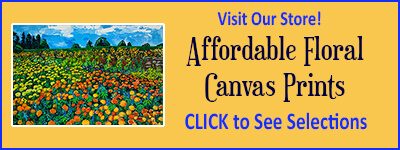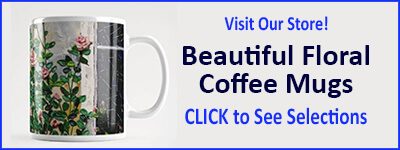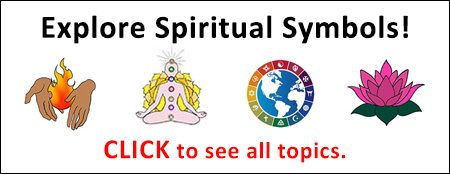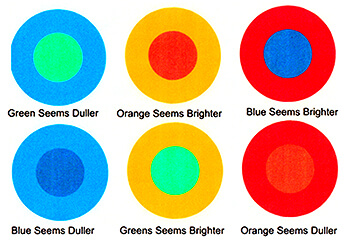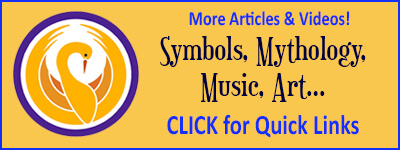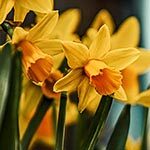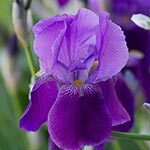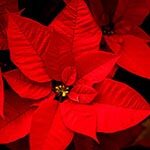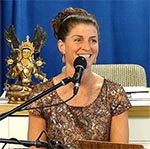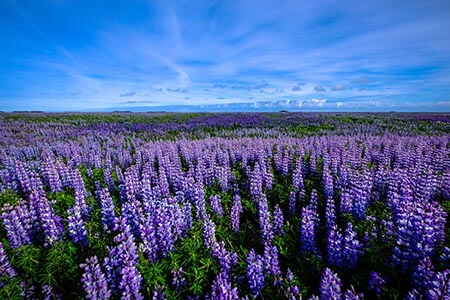
Flower Color Meanings
Understanding flower color meanings brings new life to paintings, bouquets, gardens and gift-giving! Flower color meaning can be specific even for the same type of flower. For example, a red tulip has a different meaning than a yellow tulip. However, there are general color meanings that can be useful for the creation of a garden, a bouquet, or the choice of a gift with a symbolic meaning.
Share this page with a friend!
Exploring Flower Color Meanings
The color combinations are nearly endless for bouquets and gardens. One option is to create theme around a single color or a limited number of related colors. This is usually appropriate for a solemn occasion such as a memorial service. For a birthday or other celebration, any number of colors can be used for a spectacular splash in a centerpiece or other decoration.
Flower Color Topics
This article covers flower color meaning for red, orange, yellow, white, pink, blue, purple and violet flowers. The final section includes information about creating flower color combinations in your garden: arranging a garden in layers, arranging by flower colors, and mimicking patterns in nature. Explore the flower color meanings below for some fresh ideas!
Red Flower Color Meanings
The color symbolism for red flowers includes pleasure, desire and vitality. In addition, the color red represents the will to win, love of sports, and the survival instinct. Popular red flowers include poppies, poinsettias, daylilies, tulips, pansies and zinnias.
The Impact of Red Flowers
Red flowers are stimulating and eye-catching. The intensity of red flowers creates movement and drama. On the physical level, red is recommended to support recovery from colds, and to assist with healthy circulation. As a general principle, red flowers are warming, activating and energizing.
More About Red Flower Symbolism
Bright red flowers symbolize cheerfulness and happiness. In the five element system, red is related to fire. Learn more about the five elements and sound in Five Element Mantras. Red flowers and colors have been used in literature and movies to represent courage, sexuality, love, and revenge.
Orange Flower Color Meanings
Is there anything happier and more promising than a meadow of beautiful marigolds? Orange flowers raise the spirits and symbolize the quality of joy. Cheerful orange flowers convey warmth, fire, energy, and vitality. Common orange flowers include marigolds, daylilies, nasturtiums, and calendula.
Benefits of the Color Orange
The color orange stimulates sociability and promotes emotional health. On the physical level, orange supports the health of the digestive system including the spleen, pancreas, stomach, intestines and adrenals. Some color therapists say that orange can help mitigate conditions that involve limited movement or paralysis.
Orange Flower Symbolism
Other flower color meanings for orange include creativity, confidence, intuition, friendliness and the entrepreneurial spirit. Orange is also symbolic of wisdom and renunciation as in the orange or saffron robes of Eastern monks. Learn more in our article on Marigold Meaning.
Yellow Flower Color Meanings
Yellow flowers are the heralds of spring. Sunshine yellow flowers symbolize the clearing away of the winter and stimulate clear thinking. The color meanings of yellow are enthusiasm, confidence, cheerfulness, sense of humor, fun, optimism and intellectuality.
The Power of Yellow
Yellow stimulates mental faculties as well as supporting the elimination system in the body. Yellow also aids with depression and digestion. However, too much yellow may result in nervousness and a racing mind. Learning more in our article on Sunflower Meaning.
Yellow in the Language of Flowers
Yellow flowers mean friendship in the Victorian language of flowers. This makes them the perfect gift for a friend! Well-known yellow flowers include daffodils, crocus, irises, daylilies, coneflowers, dandelions, and chrysanthemums.
White Flower Color Meanings
White flowers symbolize purity, contemplation and innocence. Many night-flowering plants are white, symbolizing the feminine energies of the moon. White awakens creativity and stabilizes energy, giving a general boost that amplifies all other colors. White flowers include daylilies, gardenias, alyssum, and baby’s breath. Learn more in our article on Daisy Flower Meaning.
The Symbolism of White
Use white to give breathing space in your garden from the intensity of bright colors demanding attention. White means purity, inner illumination and spirituality. White is associated with the metal element in feng shui and the five element system. A person attracted to white is often idealistic but may be fanatical or rigid.
Pink Flower Color Meanings
Pink flowers symbolize love and healing from grief, anxiety, or emotional trauma. A rose garden is the quintessential pink garden. Pink is related to warmth and love, gentleness, beauty, and an outward orientation. Pink is believed to awaken compassion, love and purity.
The Psychology of Pink
On the psychological level, pink eases anger and feelings of neglect. Pink can assist in alleviating emotional scars from past experiences. However, too much pink may result is hypersensitivity and emotionalism. On the physical level, pink stimulates the thymus and immune system.
Popular Pink Flowers
Fortunately, pink flowers are abundant! Pink and other pastels are often used for children and the elderly. Popular pink blossoms include chrysanthemums, irises, daylilies, camellias, azaleas, carnations, peonies, and dahlias.
Blue Flower Color Meanings
Blue flowers symbolize the peace of ocean and sky. The impact of blue flowers is cooling, relaxing and calming. As a general meaning, blue symbolizes water, the source of life. In the five elements of feng shui and other Eastern systems, blue is also associated with the water element. The color meanings of blue are related to freedom, strength and new beginnings. Blue skies mean optimism and better opportunities. Blue is the top favorite color in the world!
Symbolism of Blue
The blue lotus in Buddhism symbolizes the victory over the senses. The blue lotus is psychoactive and has been used as an aphrodisiac, sleep aid and anxiety reliever. In terms of color therapy practices, blue is recommended for children when ill, lung conditions, jaundice and rheumatism. Blue is also said to awaken intuition and ease loneliness. Blue increases emotional flexibility but can be overdone! Too much blue may hinder alertness or result in procrastination.
The Power of the Color Indigo
Indigo is a dark blue that is purported to have a sedative effect and the ability to induce deep mediation. The color indigo is recommended to strengthen the immune and lymph systems. Indigo is also advised for conditions related to the brain and head. This color is said to balance the hemispheres of the brain. Indigo flowers include the French Indigo, Natal Indigo and Guatemalan Indigo. These flowers are used to make dark blue dyes.
Varieties of Blue Flowers
Blue flowers include irises, asters, bluebells, hyacinths, periwinkles, delphiniums, anemone, bachelor buttons, forget-me-nots and morning glories. Learn more in our article on Bluebell Flower Meaning.
Purple Flower Color Meanings
Purple and violet colors soothe the mind and nerves. Some color psychologists say purple helps to relieve tension and dissipate anger and violence. Violet is related to the psychological quality of transformation, transmutation, and the balance of power and love. Additional meanings include charisma, charm, magical abilities and tolerance.
Healing Power of Violet
Violet balances physical and spiritual energies. Violet may assist in stimulating dreams at night. On the physical level, violet affects the skeletal system and assists in mineral assimilation. Some believe violet may help with arthritic conditions.
Purple Color Symbolism
Purple is the color of royalty, adding a sophisticated note to the color palette of a garden or bouquet. Deep purple indicates spiritual power. In some cultures, violet and purple are viewed as secondary colors of mourning. Purple and violet flowers include lilacs, violets, irises, pansies, sweet peas, foxglove, lupines, allium and crocuses.
Green Color Meanings
There are many reasons why bouquets are used so often as get well gifts! In addition to the meaning of flower colors, the beautiful green leaves, stems and decorative foliage in bouquets also have symbolic meaning. Green increases sensitivity and compassion. The bright colors of the flowers contrasted with the green of the supporting foliage is a wonderful uplift under any circumstances.
Healing with the Color Green
On the physical level, green helps to soothe inflammations. As a general meaning, green is restful and revitalizing at every level. Green is related to the wood element in the Chinese five element system. In terms of color therapy, green is the color recommended for ulcers, heart conditions, high blood pressure, exhaustion and headaches.
Finding the Balance of Green
On the other hand, too much green can result in competitiveness and rapid growth that is not sustainable. Green can also be related to nausea. However, a balanced amount of green is the perfect symbol of new life and hope.
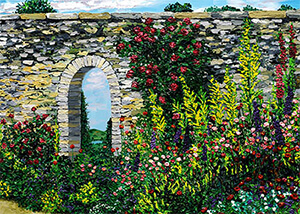
Flower Color Meanings in Gardens
Gardening for pleasure as well as gardening to grow food is a universal human occupation. Achieving color harmony, contrast and effective color combinations is a fascinating art. Likewise, artwork itself can be chosen based on the colors of the flowers depicted. Knowing flower color meaning will bring your appreciation of flowers to a whole new level.
Creating a Memorable Garden
In addition to gifts and bouquets, gardens can be created in honor of a loved one who has passed on or as a celebration for a special event such as an outdoor wedding. Creating a beautiful garden is like painting a picture in living color.
Arranging a Flower Garden
Flowers can be combined in gardens in a variety of interesting ways. Flowers can be arranged in layers, by color, in natural groupings, or by time of bloom. Non-flowering plants and vegetables can be used to add foliage and structure.
Gardens for Sensory Experiences
Some gardens are also created with smell in mind and contain flowers that give off fragrant perfume throughout the growing season. Try one of these possibilities for combining flowers in your garden this year and enjoy the results all summer long!
Arrange a Garden in Layers
To arrange a garden by layers, start at the back. Usually three tiers are sufficient, and the third tier is the tallest layer of plants. This tier is located either at the back or on the sides furthest from the viewer’s eye. For very large gardens, this tier can be a tree line. For smaller gardens, shrubs or the tallest plants to be included in the garden can be used.
Creating Colorful Garden Tiers
Second and first tier plants can be somewhat merged with the third tier to give the garden different dimensions from different angles. This also helps to avoid an overly structured, highly formal garden. Low-lying ground cover can constitute the first tier and varying heights of intermediate level flowers can ease the transition from the lowest layer of flowers to the tallest.
Arranging a Garden By Color
The key to remember when arranging gardens by color is that colors look different depending on the colors placed next to them. Bright colors jump forward whereas pastels recede visually. Colors with the same hue or intensity can stand well next to each other.
Creating Excitement in Your Garden
Opposite colors will create excitement and a sense of action. Gardens are usually arranged around a main color, such as red, with all of the other colors functioning in secondary roles. This helps avoid competing colors that create too much tension rather than a relaxing effect.
Using Color Science in Flower Gardens
The science of color placement began in the modern era with the French scientist M.E. Chevreul (1786-1889), author of The Principles of Harmony and Contrast of Colors. Chevreul was hired to help France become the foremost tapestry producer. This necessitated the creation of the most colorful dyes possible. Chevreul’s work in the field yielded a new scientific law: The Law of Simultaneous Contrast of Colors. This law was considered to be as significant as those of Newton two centuries prior.
Color Placement and Impressionism
Chevreul’s work, published in 1839, became the basis of impressionistic art. By placing strokes of paint next to one another, artists were able to capitalize on the way that our brains and eyes interact. The human eye is not fixed, but moves constantly.
Color and the Human Brain
The brain is built to see blades of grass, petals of flowers, and the leaves of trees in constant motion. This principle applies to flower color placement in gardens as well as artwork. The brain likes color contrast and small irregularities.
Arrange a Garden to Mimic Nature
Arranging gardens by natural groupings of plants mimics the patterns set in nature. This can be accomplished by placing plants adjacent to each other that would naturally grow together in the wild or by grouping plants that bloom at the same time.
Choosing Complementary Flowers
Plants naturally grow together when their sizes and leaf shapes complement each other so that they are not competing for sunlight or other resources. When plants are grouped by time of bloom, the focus for the garden can shift as the season progresses. Each area of the garden has a time when the attention is focused on the blossoms in that area.
Healing with Flowers
The power of flowers and their colors to heal has long been recognized. In addition. many flowers are used in herbal medicine. Flowers can be used to create teas, tinctures and poultices for various conditions. The following sections contain specific methods of using flowers as agent of healing.
Bach Flowers Therapy
In the 19th century, Dr. Edward Bach created a system of healing that became known as the Bach Flower Remedies. Dr. Bach was a London physician who believed that disease is a manifestation of negative mental states. He established seven major color groups and color associations based on flowers and plants. The colors are a complementary set of two colors on a graduated spectrum.
Homeopathic Flower Remedies
Dr. Bach then created a type of homeopathic remedy with the flowers to bring about physical, mental and emotional healing. The diluted remedies were taken until healing had been achieved. Learn more on the web about Bach Flower remedies. Examples of the color combinations, mental states and associated flowers are given below:
Mental State: Despondency
Color Spectrum: Orange to Blue
Flower Example: Holly
Mental State: Lack of Interest in Life
Color Spectrum: Yellow to Turquoise
Flower Example: Wild Rose
Mental State: Overcare for Others
Color Spectrum: Magenta to Green
Plant Example: Beech
Mental State: Uncertainty
Color Spectrum: Red to Green
Flower Example: Sceleranthus
Mental State: Loneliness
Color Spectrum: Pink to Green
Flower Example: Impatiens Flowers
Mental State: Oversensitivity
Color Spectrum: Orange to Blue
Flower Example: Centaury
Flowers and Color Therapy
There are two basic forms of color therapy: direct and indirect. Direct color therapy involves actively shining colored light on the body, using color along acupuncture meridians, or intaking colors through food or essential oils. More about essential oils can be found in Chakras and Essential Oils. Color therapy can also include mental intake of colors through visualization, color meditation, or color breathing.
Color in a Healing Environment
Indirect color therapy involves placing chosen colors in the environment. This includes using specific colors in a garden for outdoor environments or in artwork for indoor environments. Nature scenes in general have therapeutic effects. Curvilinear and organic shapes elicit relaxation. On the other hand, geometric forms are stimulating.
Science of Therapeutic Color
A sequence of studies by Ulrich, Simons, and Honeyman (1979, 1986, 1987) demonstrated that nature scenes reduce negative emotions such as fear, anger, and sadness. In addition, these studies showed that nature scenes may block or reduce stressful thoughts. Finally, nature scenes were found to foster recovery by eliciting physiological changes in blood pressure and muscle tension.
Using Flowers for Therapy
The presence of flowers may further enhance this effect. The tradition of bringing flowers to patients as a get well gift may be deeply rooted in our instinct towards colors for healing. Using flowers in waiting rooms, reception areas and therapy rooms could take advantage of this biological mechanism.
Healing Power of Colorful Flower Art
Flower art has been a popular since humankind began to create art! The love of colorful flowers crosses all cultural and historic boundaries. Flowers have inspired and fascinated mankind as long as history has existed. Flowers accompany us is every major event in life.
Flower Art for Stress Reduction
Can the decor in a room help relieve stress? A 1996 study conducted by Virginia Lohr and others showed that rooms and offices decorated with plants and flowers helped reduce stress as measured by decreased blood pressure and pulse rates. Researchers have further determined that there is a direct link between colorful flowers and life satisfaction.
Flowers Alleviate Depression
A study done at Rutgers demonstrated that flowers decrease anxiety, depression and agitation. The beauty and cheerful colors of flowers also lead to a higher sense of enjoyment and increased contact with family and friends. Flowers make a home more welcoming and create a sharing atmosphere.
Flowers Increase Communication
Additional research by Diane Relf of the Virginia Polytechnic Institute has shown that people communicate better in the presence of flowers or plants and they tend to eat more slowly. Others studies focused specifically on seniors and tracked improvements in memory in the presence of flowers.

Colorful Flower Art for Interiors
By decorating your home or office with flower paintings rather than fresh flowers, you introduce flowers into your decor that will never fade. Having flowers as a permanent element into your home can be a positive influence for both inhabitants and visitors. With all of the prints and posters available today, choose a flower painting to decorate any area of your home or business is relatively easy.
Selecting Flower Art for Home or Office
Floral paintings can be used in almost every area of a home or business. Small flower paintings are perfect for bathrooms, hallways, entryways or bedrooms. Large flower paintings add cheer and color to dining rooms, living rooms and family rooms. For businesses or offices, flower paintings are traditional for waiting areas and reception areas. Flowers have universal appeal and work well in just about any decor to lower stress and uplift everyone’s mood!
Flower Art for Children’s Rooms
When it comes to decorating a room for a child or baby, images of nature are ideal. Although cartoon characters and larger-than-life murals are popular for children’s rooms, studies done in children’s hospitals have shown that these images can actually be distressing and frightening for small children.
Benefits of Flower Art
Research indicates that images of nature are more soothing and restful and provide a positive stimulation for both babies and young children. Babies and children also prefer strong colors. Bright, cheerful images featuring primary colors (red, blue, yellow) and secondary colors (green, orange and purple) are good choices for nurseries and children’s rooms.
Floral Images for Babies
When decorating with flower art, both sweet peas and bluebells are traditionally associated with babies. Sweet peas are usually for girls and bluebells for boys. Sweet peas are symbolic of delicate pleasure. Bluebells are symbolic of humility and gratitude. Bluebells are also associated with fairies and are sometimes called “fairy thimbles.” Learn more in our articles on Sweet Pea Flower Meaning and Bluebell Flower Meaning.
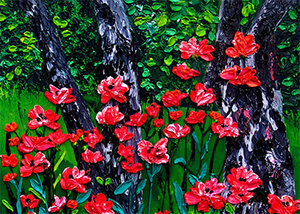
Colorful Flower Art for Long-Term Care
Appropriate gifts for long-term care and hospital patients involve a number of considerations: tight storage space, limited display space, and the need for comfort and beauty. Small pieces of art and other decorative items also make perfect gifts for long-term care and hospital patients with limited display space.
Artwork and Nature Therapy
In addition, art can have therapeutic value for long-term care patients and hospital patients. Research has shown that images of nature: reduce stress and mental fatigue, speed recovery from illness, relieve depression, reduce negative emotions, lower blood pressure, reduce muscular tension and increase brain activity in the alpha range.
Healing Gifts for Patients
Nature images dominated by water or trees and flower art can have healing effects and make wonderful gifts for long-term care and hospital patients. Florence Nightingale was among the first believers in attractive surroundings for patients. She claimed that she had witnessed the sight of beautiful flowers directly reducing a fever!
Color Symbolism in Therapeutic Art
The colors used in art can also have therapeutic value. Warm colors (red, yellow and orange) can be used to alleviate depression and to stimulate metabolism. An image of marigolds would be an appropriate choice to introduce warm colors.
Using Cooling Colors
Cool colors (green, blue and purple) can help to offset fevers, relieve exhaustion and encourage relaxation. Lupines, irises and bluebells would be good options for flower art in the cooling color range. Give a patient a long-term lift with beautiful flower art!
Flowers in Near Death Experiences
A high percentage of people who have near death experiences see gardens. These gardens almost always exhibit vibrant flower colors. A description by a nurse (Derry Bresee, online journal, 2004) describes “a heavenly garden” where “quiet light emanated from each plant, and from the water in the bubbling brook…. The green of the plants was so vibrant and so many shades of green! All of the plants glowed from within….”
Otherworldly Color and Gardens
Another NDE experiencer, Christian Andreason, reported: “I was walking through this garden, looking at all these dolorful flowers that are alive, and there’s all this beautiful beyond blue water that is sparkling and tingling as it sings.” Many NDErs describe the experience of color and flowers as something beyond what we can experience on earth.
Beautiful Heavenly Gardens
Another description of a near death experience included the following: “I then found myself being escorted by this loving being of light to the most beautiful garden that anyone could dream imaginable.” The color of the flowers is repeatedly described as emanating somehow from within the flowers rather than being simply part of their biological makeup.
More Flower Articles
FLOWER COLOR MEANINGS ARTICLE SUMMARY
The root of flower color meaning is found in the psychology of colors in general. in addition, some flowers have historic meanings or uses. This article covers flower color meaning for red, orange, yellow, white, pink, blue, purple and violet flowers. The next time you are planning a garden or choosing a gift, don’t forget to consider flower color meaning!
Author Kathleen Karlsen
Kathleen Karlsen is a musician, artist, writer and speaker. She is the author of two books (Flower Symbols and Vocal Medicine) and over 200 articles. Kathleen, her husband Andrew, and their five children live in Bozeman, Montana. More about Kathleen Karlsen.


